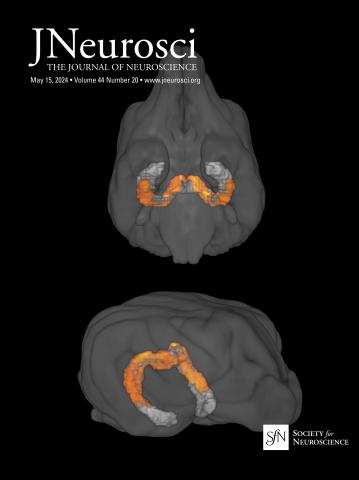Nicotine Withdrawal Drives Aversive Behaviors by Recruiting Inhibitory Interpeduncular Nucleus Inputs to the Laterodorsal Tegmentum in Mice.
IF 4.4
2区 医学
Q1 NEUROSCIENCES
引用次数: 0
Abstract
Nicotine addiction remains a major cause of disease and premature death worldwide. Nicotine modulates neural pathways that underlie both rewarding and aversive behavioral effects, but persistent activation of brain reward circuitry drives nicotine consumption despite the negative consequences. When nicotine users attempt to quit, additional neural mechanisms are recruited to generate an aversive withdrawal state, which contributes to the remarkably high relapse rate among nicotine users. The interpeduncular nucleus (IPN) and its presynaptic inputs from the medial habenula are key mediators of aversive nicotine withdrawal symptoms, but the downstream neural targets mediating these effects are unknown. The aversive effects of acute exposure to high doses of nicotine require inhibitory IPN GABAergic projections to the laterodorsal tegmentum (LDTg), a key driver of reward-related dopamine signaling. Here we show that optogenetic inhibition of these IPN-LDTg projections reduces behavioral and physiological effects of nicotine withdrawal in male and female mice. Using fiber photometry, we found that nicotine withdrawal reduced reward-related signaling with decreases in both LDTg neuronal activity and nucleus accumbens dopamine release. These studies demonstrate a direct link between aversive and appetitive neural pathways that is active during nicotine withdrawal, providing novel targets for treating nicotine addiction.Significance Statement The likelihood of relapse to drug taking is higher for nicotine than all other addictive drugs. While the rewarding effects of the drug and strong cue associations are known to contribute to relapse, avoidance or reduction of withdrawal symptoms is a major factor driving individuals back to nicotine consumption. Indeed, one of the key features of available treatments for nicotine abuse is amelioration of withdrawal signs. Therefore, understanding the neural mechanisms underlying the symptoms of nicotine withdrawal is critical for identifying new treatment strategies. Here we provide compelling evidence that inhibitory projections from the interpeduncular nucleus to the laterodorsal tegmental nucleus is an essential mediator of the symptoms of nicotine withdrawal.尼古丁戒断通过向小鼠外侧背盖招募抑制性核输入来驱动厌恶行为。
尼古丁成瘾仍然是世界范围内疾病和过早死亡的主要原因。尼古丁调节的神经通路是奖励和厌恶行为效应的基础,但大脑奖励回路的持续激活驱使尼古丁消费,尽管有负面后果。当尼古丁使用者试图戒烟时,额外的神经机制被招募来产生厌恶的戒断状态,这有助于尼古丁使用者显著高的复发率。核间核(IPN)及其来自内侧缰核的突触前输入是令人厌恶的尼古丁戒断症状的关键介质,但介导这些作用的下游神经靶点尚不清楚。急性暴露于高剂量尼古丁的不良反应需要抑制IPN gaba能投射到侧背被(LDTg),这是奖励相关多巴胺信号的关键驱动因素。本研究表明,光遗传学抑制这些IPN-LDTg投射可减少雄性和雌性小鼠尼古丁戒断的行为和生理影响。使用纤维光度法,我们发现尼古丁戒断减少了与奖励相关的信号,LDTg神经元活动和伏隔核多巴胺释放均减少。这些研究表明,在尼古丁戒断期间,厌恶和食欲神经通路之间存在直接联系,为治疗尼古丁成瘾提供了新的靶点。意义声明尼古丁的复吸可能性比其他所有成瘾性药物高。虽然已知尼古丁的奖励效应和强烈的线索关联会导致复发,但避免或减少戒断症状是驱使人们重新摄入尼古丁的主要因素。事实上,现有的尼古丁滥用治疗方法的关键特征之一是改善戒断症状。因此,了解尼古丁戒断症状背后的神经机制对于确定新的治疗策略至关重要。在这里,我们提供了令人信服的证据,从脚间核到外侧背盖核的抑制性投射是尼古丁戒断症状的重要中介。
本文章由计算机程序翻译,如有差异,请以英文原文为准。
求助全文
约1分钟内获得全文
求助全文
来源期刊

Journal of Neuroscience
医学-神经科学
CiteScore
9.30
自引率
3.80%
发文量
1164
审稿时长
12 months
期刊介绍:
JNeurosci (ISSN 0270-6474) is an official journal of the Society for Neuroscience. It is published weekly by the Society, fifty weeks a year, one volume a year. JNeurosci publishes papers on a broad range of topics of general interest to those working on the nervous system. Authors now have an Open Choice option for their published articles
 求助内容:
求助内容: 应助结果提醒方式:
应助结果提醒方式:


